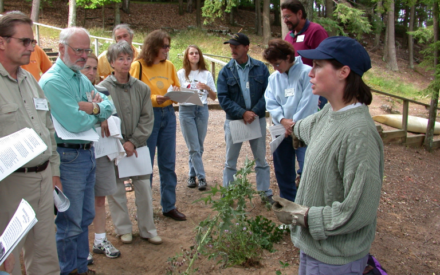
Cranberries are Wisconsin’s largest fruit industry and an important economic driver. The almost $1 billion industry employs nearly 4,000 people in Wisconsin. Cranberry marshes cover 21,000 acres of Wisconsin’s land. Wisconsin produces more cranberries than any other state, with more than 60 percent of the United States’ production coming from the state. Consumers at home and abroad enjoy the fruit as fresh berries, sauce, juice, sweetened dried cranberries, and more.
More than 250 cranberry farms grow fruit in 20 of Wisconsin’s central and northern counties. In the last 15 years, increased consumer demand for cranberry products has led growers to renovate marshes, geneticists to develop new varieties, and investors to back the industry. Since fruit is handled differently for different products – for example juice vs. fresh fruit vs. sweetened dried – different growing practices may soon be employed so growers can have more control over color, size, shape, and firmness characteristics for each end market.
Extension’s support of the cranberry industry’s needs
University of Wisconsin-Madison supports the state’s cranberry producers through the applied research programs of four College of Agricultural and Life Sciences (CALS) faculty and Extension state specialists:
- Jed Colquhoun, CALS Department of Horticulture, specializing in weed management;
- Amaya Atucha, CALS Department of Horticulture, specializing in general production;
- Christelle Guedot, CALS Department of Entomology, specializing in insect pests; and
- Leslie Holland, CALS Department of Plant Pathology, specializing in diseases.
To most effectively connect the specialists’ research programs to the industry, UW-Madison’s Division of Extension recognized a need to increase communication and outreach to producers by creating a unique position called a Cranberry Outreach Specialist. This position provides Wisconsin cranberry growers with a resource for timely cranberry production questions and information to optimize Wisconsin cranberry yield and quality – and, therefore, cranberry farm profitability. The position is based in the cranberry production region of the state to establish relationships with growers and connect them to research-based, best management practices. The outreach specialist also works closely with the Extension state specialists to improve the feedback loop and tailor research to the growers’ greatest long-term needs. This position has been championed and supported by the Wisconsin State Cranberry Growers Association (WSCGA).
Industry needs
For the industry to remain highly competitive, three challenges were identified that the Cranberry Outreach Specialist position could gain traction in the first growing season. These included:
- Better nutrient management;
- Better understanding of spring frost protection; and
- Better control of insect pests.
Response
In response to the three challenges identified, two primary outreach strategies were developed and implemented by the new Extension Cranberry Outreach Specialist in close collaboration with UW-Madison CALS/Division of Extension state specialists.
Virtual Brown Bag meetings
The first strategy was a monthly educational online meeting called “Virtual Brown Bag meetings” that were offered during the lunch hour, a convenient time for both farm owners and workers. The program brought growers into a virtual forum with experts who shared timely research results and strategies for addressing pests and spring frost protection. Participation steadily increased each month, from 40 attendees at the first meeting in May to more than 100 attendees in meetings preceding harvest.
Cranberry Crop Management Journal
The second strategy employed the reinvigoration of the Cranberry Crop Management Journal (CCMJ), a publication published every three weeks during the growing season. Archived issues and timely blog posts were posted to the Fruit Program’s website: fruit.wisc.edu/cranberries. In addition to appreciative feedback from growers and researchers alike, subscribership for the 2020 growing season increased from 247 to 342.
Growers who attended the Virtual Brown Bag meetings or read the Cranberry Crop Management Journal indicated that they gained insights and changed practices in the three identified issue areas.
In-depth: Outcomes
Better nutrient management
The proliferation of new cranberry varieties (which optimize yield, are more disease resistant, use nutrients more efficiently, and can have more desirable taste and health) creates an opportunity to optimize fertility management, while saving growers money and growing a superior product. Management strategies based on a marsh’s soil type are important for growers to understand. Furthermore, research into better nutrient management suggests that development of best management practices would be well-received by growers.
Both growers and crop consultants expressed that they learned new strategies that they intend to put into practice. Some attendees and readers provided feedback on changes they made this year while others were grateful for changes they can implement in the future. One grower committed to following the nitrogen and potassium recommendations presented and developed a management plan for the coming years as a result of the piece.
Better understanding of spring frost protection
One of the most delicate times for cranberry vines is spring, when the plants transition from winter dormancy into producing new growth. Though research has not been done on all cranberry varieties, growers fill those knowledge gaps by drawing on experience and employing “rules of thumb.” Tradition still governs many growers’ management decisions, especially on varieties that haven’t received research attention yet.
Through better understanding of the existing research on spring frost tolerance, this year some growers committed to taking field notes on differences as several of their varieties came out of dormancy. This information will be used to guide fall frost watch decisions, and in the future to spur analysis of varietal changes. Grower feedback resulted in a plan by researchers to mount variety-specific phenotype cameras to begin to inform future research.
Better control of pests while protecting pollinators
Due to export markets demanding reduction of insecticides, growers face increased challenges in controlling pests. Pollinators are of primary importance to cranberry growers ensuring high yields. Wild pollinator populations are encouraged, and domesticated pollinators are brought in during blossom. Pollinator health and market restrictions give cranberry growers a very tight rope to walk in controlling pest populations, even though insect pests can be devastating to yield.
Growers applied what they learned by changing pest management practices to protect pollinators while dealing with destructive pests. For example, one grower decided not to spray for leafhoppers during blossom hence not putting pollinators at risk. Though the grower was nervous about delaying his application, when it was applied, it was successful. The grower has since established a monitoring plan and will proactively treat, if necessary, in the spring of 2021 when cranberry flowers are not in bloom. Another grower applied what was taught in the CCMJ and has reduced insecticide applications. Three new marshes have also requested to participate in the nematode research project after hearing about it during a Virtual Brown Bag meeting. These marshes, who identify cranberry flea beetles as their single largest issue, will be able to assess the possibilities of this native predator in controlling flea beetle populations in their unique environments next year.
Overall Outcomes, Promising Future
Through improving grower nutrient management practices, frost protection decisions, and insect management, the cranberry industry directly benefited in 2020 by applying fertilizer when it would be most useful (reducing financial loss), by targeting frost protection measures (reducing fuel and water consumption while easing strain on employees), and by reducing insect feeding damage while promoting pollinator health.
In coming years, each of these impacts will be deepened, and improvements will be made to all programs based on grower feedback. Extension and USDA specialists are already eager to adapt their research to the needs growers and the Cranberry Outreach Specialist identify as the most promising, profitable, and useful for the industry. Some surveys have been conducted as well. In a quick poll in the June Virtual Brown Bag session, 78 percent of people learned more than one new thing, 22 percent learned one thing, and zero had already known all the information.
The future potential of the Cranberry Outreach Specialist role in tightening the feedback loop between University research and growers was stated well by a grower, ‘Thank you all for helping us with this unusual situation. We appreciate the efforts of everyone involved, it’s awesome to have such dedicated and talented people leading research and grower engagement.” Connecting growers with the information they need so that they can protect their crop in an evidence-based way will be the mark of success of the Cranberry Outreach program.
To Learn more about this program, contact:
Allison Jonjak, Cranberry Outreach Specialist
UW-Madison, Division of Extension
(612) 276-2872
Allison.Jonjak@wisc.edu
Download Article

 Planning AHEAD: End-of-Life Planning
Planning AHEAD: End-of-Life Planning Business Planning for Profitable, Safe Farms
Business Planning for Profitable, Safe Farms Woodland Wildlife Management Program for Private Landowners
Woodland Wildlife Management Program for Private Landowners Positive Coping Strategies to Reduce Stress
Positive Coping Strategies to Reduce Stress


